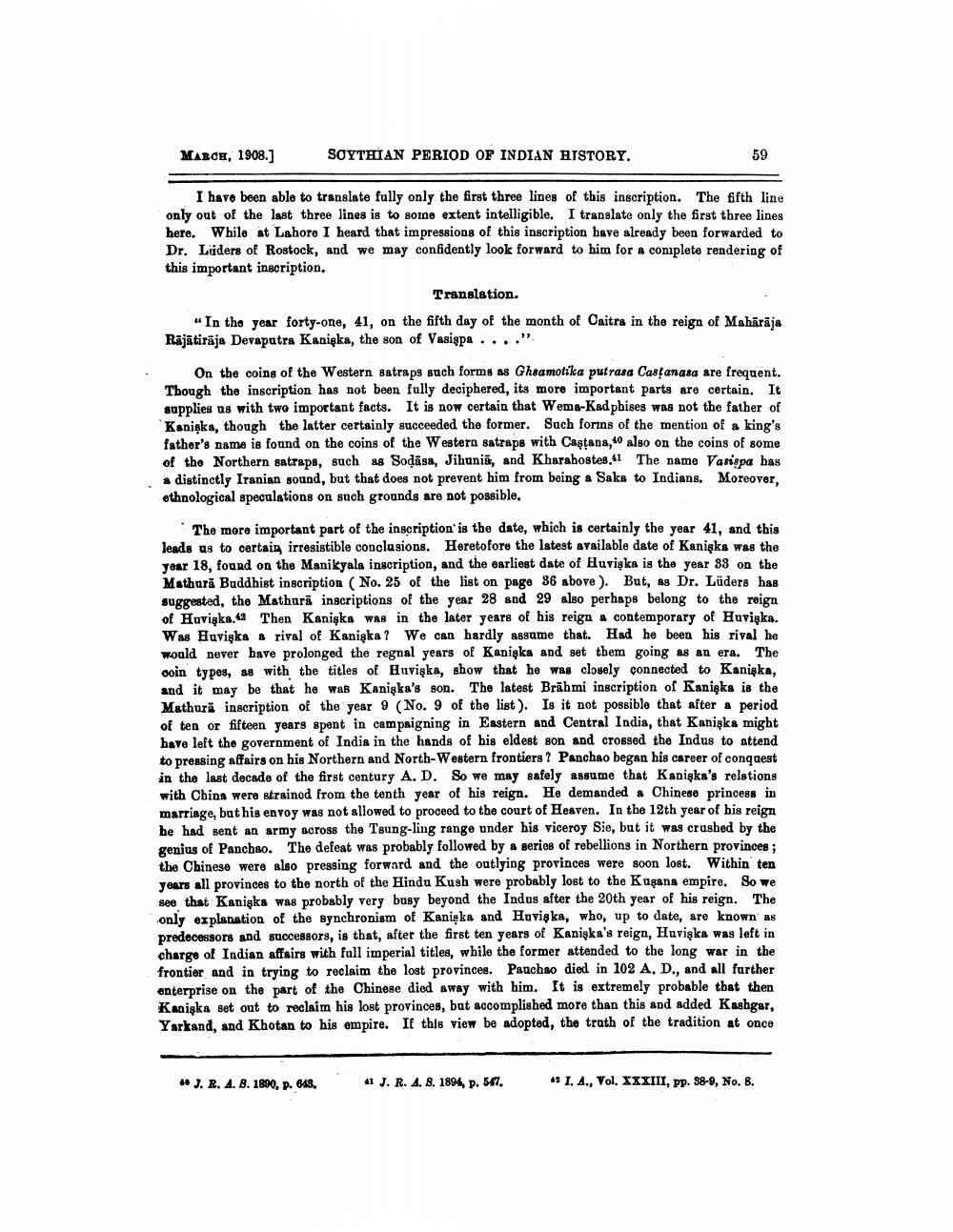________________
MARCE, 1908.)
SOYTHIAN PERIOD OF INDIAN HISTORY.
59
I have been able to translate fully only the first three lines of this inscription. The fifth line only out of the last three lines is to some extent intelligible. I translate only the first three lines here. While at Lahore I heard that impressions of this inscription have already been forwarded to Dr. Lüders of Rostock, and we may confidently look forward to him for a complete rendering of this important inscription.
Translation. In the year forty-one, 41, on the fifth day of the month of Caitra in the reign of Mahārāja Rājātirāja Devaputra Kaniska, the son of Vasi pa ...."
On the coins of the Western satraps such forms as Ghsamotika putrasa Castanasa are frequent. Though the inscription has not been fully deciphered, its more important parts are certain. It supplies us with two important facts. It is now certain that Wema-Kad pbises was not the father of Ksnika, though the latter certainly succeeded the former. Such forins of the mention of a king's father's name is found on the coins of the Western satraps with Caştana, 40 also on the coins of some of the Northern satraps, such as Sodāsa, Jihunia, and Kharabostes. The name Vasispa has a distinctly Iranian sound, but that does not prevent him from being a Saka to Indians. Moreover, ethnological speculations on such grounds are not possible.
The more important part of the inscription is the date, which is certainly the year 41, and this leads us to certain irresistible conclusions. Heretofore the latest available date of Kanigka was the your 18, found on the Manikyala inscription, and the earliest date of Huviska is the year 83 on the Mathura Buddhist inscription No. 25 of the list on page 86 above). But, as Dr. Lüders has suggested, the Mathură inscriptions of the year 28 and 29 also perhaps belong to the reign of Huvişka. Then Kanişka was in the later years of his reign a contemporary of Huviska. Was Huvişka a rival of Kaniska? We can hardly assume that. Had he been his rival he would never have prolonged the regnal years of Kanişka and set them going as an era. The coin types, as with the titles of Huviska, show that he was closely connected to Kanişka, and it may be that he was Kaniska's son. The latest Brāhmi inscription of Kaniqka is the Mathura inscription of the year 9 (No. 9 of the list). Is it not possible that after a period of ten or fifteen years spent in campaigning in Eastern and Central India, that Kanişka might have left the government of India in the hands of his eldest son and crossed the Indus to attend to pressing affairs on his Northern and North-Western frontiers ? Panchao began his career of conquest in the last decade of the first century A. D. So we may safely assume that Kanişka's relations with China were strainod from the tenth year of his reign. He demanded Chinese princess in marriage, but his envoy was not allowed to proceed to the court of Heaven. In the 12th year of his reign he had sent an army across the Tsung-ling range under his viceroy Sie, but it was crushed by the genius of Panchao. The defeat was probably followed by a series of rebellions in Northern provinces; the Chinese were also pressing forward and the outlying provinces were soon lost. Within ten years all provinces to the north of the Hindu Kush were probably lost to the Kuşana empire. So we see that Kanigks was probably very busy beyond the Indus after the 20th year of his reign. The only explanation of the synchronism of Kanişka and Huviska, who, up to date, are known as predecessors and successors, is that, after the first ten years of Kanişka's reign, Huviska was left in charge of Indian affairs with full imperial titles, while the former attended to the long war in the frontier and in trying to reclaim the lost provinces. Pauchao died in 102 A, D., and all further enterprise on the part of the Chinese died away with him. It is extremely probable that then Kaniska set out to reclaim his lost provinces, but accomplished more than this and added Kashgar, Yarkand, and Khotan to his empire. If this view be adopted, the trath of the tradition at once
** J. R. A. 8. 1890, P. 648,
J. R. A. 8. 1894, p. 547.
21. A., Vol. XXXIII, pp. 38-9, No. 8.




